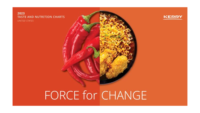In contrast to the meat case, refrigerated plant-based meat alternatives continued to lose sales in September 2022 when compared to the prior year, according to IRI retail sales data, generating $30 million in sales for the month and down -17.1% versus September 2021. Most refrigerated meat substitutes were down year-on-year in both dollars and pounds sold.
But while sales for meat alternative products may be languishing in the current inflationary retail environment, 29% of the population reports limiting consumption of meat in some way, according to Datassential's 2022 Plant-Forward Opportunity Report, a collaboration with the Culinary Institute of America, Food for Climate League and the Menus of Change University Research Collaborative. More than one-third (36%) of Gen Z may be considered meat limiters, as Gen Z sports a higher proportion of vegans, vegetarians and pescatarians.
During the recent Plant Based Foods Association’s Plant Based World Expo North America in New York, plant-based protein trends on display included:
- mushroom-based meats, snacks and jerky
- plant-based seafood
- and global culinary creativity and a focus chef-crafted products.
“In many cultures around the world, alternative proteins are used often side-by-side with meat proteins,” said Christopher Koetke, corporate executive chef at Ajinomoto Health and Nutrition North America Inc. “For example, in ramen, a traditional meat-based broth is topped with tofu and veggies alongside meat or egg. In addition to health and sustainability concerns, I think we’ll be seeing a lot more of this due to the growing influence of global cuisine on American dining.”
Danny O’Malley, president and founder of Before the Butcher, which produces plant-based proteins for foodservice, retail and use as an ingredient by other manufacturers, said flavors such as curry or Latin-inspired flavors are influencing new product development.
“There are so many different regional flavor profiles that are starting to come into the game,” O’Malley said, adding that Before the Butcher’s chorizo is one of the company’s hot products.
Consumers expect to find restaurant menu options that cater to their preferences and eating styles — and they expect to find them at all levels of restaurants, not just in niche plant-based establishments.
“Chefs have the tricky job of balancing demands for better nutrition in meat alternatives while still making them taste delicious,” Koetke said. “This is a key area of innovation for us in partnership with food service operators.”
Menu and product developers have a wide range of ingredients that can be used when developing plant-based dishes, including vegetables such as mushrooms, legumes such as soy/tofu, beans, and chickpeas, and wheat- and grain-based alternatives.
“Many alternative proteins are also recognized as a ‘blank slate’ in terms of flavor, as they will easily take on the flavor of other ingredients and spices,” he said. “This gives chefs and developers the creative freedom and versatility to use some form of meat alternative with virtually any flavor or global influence.”
Some alternative proteins offer more flavor-forward, assertive taste profiles.
“Umami and kokumi are excellent tools in creating well-flavored products,” Koetke said. “Texture is also important in alternative proteins, and our experience with using enzymes like transglutaminase has helped us achieve satisfying meat-like textures.”
At a time when rising prices are squeezing businesses as well as consumers, Koetke said alternative proteins’ flexibility allows foodservice operators to offer multiple menu items using the same base alternative protein and changing how it is prepared or what other ingredients accompany it
“This is a great strategy for offering variety while keeping the variety of inventory low,” he said.
Seafood analogs is a trending product innovation in the category.
“We’re currently seeing a sharp rise in consumer interest in plant-based seafood, primarily due to sustainability concerns like overfishing and bycatch hazards, and product development is struggling to keep pace,” Koetke said.
Beyond plant-based seafood, Koetke said chefs would like to see meat alternatives on different dayparts and menu sections.
“Apart from vegan restaurants, most foodservice establishments offer one or two alternative protein dishes, but I’d love to see multiple plant-based options throughout appetizers and entrees, even desserts made with egg or dairy alternatives, to reflect how mainstream plant-forward diets are becoming,” he said. “Fine-dining restaurants often have more freedom to experiment, as their diners tend to be more adventurous and open to trying new ingredients and cuisines. Family or fast casual customers look for more familiar offerings perhaps with a creative twist.”
A fine-dining establishment may opt for hen of the wood mushrooms as part of a vegetarian entrée, while a fast casual restaurant may rely on less costly ingredients like legumes or button mushrooms as the base of a meat alternative option, he said.
Preparing a variation on a traditional dish can be a way to introduce diners to eating new protein sources, he said.
“The ‘flexitarian’ diet recognizes that many people want to eat more vegetable-based cuisine without wanting to fully commit to a vegan or vegetarian lifestyle,” Koetke said. “Ajinomoto Health and Nutrition recently developed a prototype for a flexitarian burger, made with 50% ground beef and 50% plant-based ingredients. The burger contains half as much saturated fat as a 100% meat patty and has nearly a two-thirds reduction in cholesterol. The taste and texture are very much like a beef patty.”
He adds, “In the hands of a creative chef, alternative proteins can fit into many cooking styles and cuisines. It’s about choosing which alternative protein goes with which ingredients per the desired outcome.”

.png?height=96&t=1647275041&width=96)



Report Abusive Comment